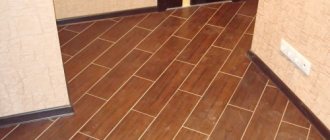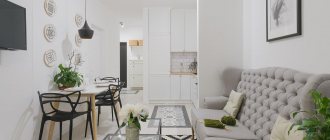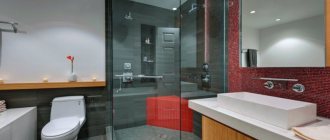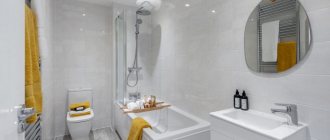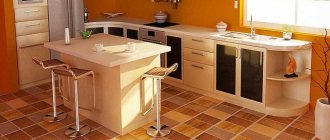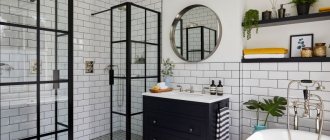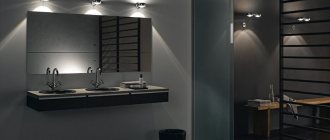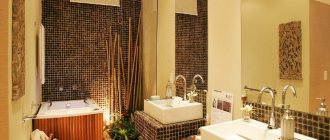It is necessary to select finishing materials at the renovation planning stage. You need to be especially careful when choosing finishes in the bathroom, since all coatings in this room are exposed to steam and water. Let's figure out how to cover the bathroom floor so that the coating turns out reliable and beautiful.
Construction stores offer a wide selection of finishing materials, so choosing a finishing option can be difficult. But when choosing a bathroom coating, you need to pay attention not only to the beauty of the material, but also to the ability to operate it in difficult conditions of high humidity and temperature changes.
No. 1. Ceramic tile
Ceramic tiles are the most popular material used today for finishing floors in the vast majority of bathrooms. Such widespread popularity is explained by a number of advantages of tiles:
- the material is absolutely not afraid of moisture and does not absorb it, which means that it will not deform under the constant influence of water, and mold will not appear on it;
- hygienic coating and ease of maintenance. Moreover, dust does not collect on the tiles, since they do not accumulate electrostatic charge;
- strength and abrasion resistance. These qualities make floor tiles strikingly different from those used for wall decoration;
- anti-slip properties;
- fire resistance, as well as high thermal conductivity, which allows you to equip a system of heated floors;
- huge assortment. Modern manufacturers offer tiles of different sizes and colors, with different patterns and ornaments, stylized to resemble other materials, so you can always choose exactly the option that will best suit the design idea.
Among the disadvantages is the fragility of the tiles: if you suddenly drop a heavy object on the floor, there is a high probability of damaging the coating, and replacing the tiles will require some effort. Tiles are considered a cold material, so walking on them barefoot will not be very pleasant, but there is a way out - installing heated floors.
Coating options
Many people believe that the only acceptable material that can be used to decorate a bathroom floor is ceramic tiles. This is not a wrong opinion, although tile flooring is certainly one of the best options. In addition to tiles, you can use the following to finish the bathroom floor:
- Linoleum or vinyl tiles. This is a budget option, it is perfect if you need to make inexpensive but high-quality repairs.
- Laminate. A somewhat unexpected decision, since most consumers are well aware that laminate does not tolerate moisture well. In fact, everything is simpler - you should use moisture-resistant types of material for the bath.
- Polyurethane. You can create a seamless and original-looking floor covering using self-leveling technology.
- Cork. This is a very comfortable but quite expensive finishing option.
Let us consider the features of each of the listed materials in more detail.
No. 2. Linoleum
Many people are quite skeptical about using linoleum in the bathroom, and there are good reasons for this. But still, if you choose the right material and lay it correctly , then serious problems should not arise. Another thing is that not everyone succeeds in fulfilling all the conditions for proper installation, hence the sad experience. If you want to create an interesting interior in the bathroom and have a “warm” coating, then you will have to take into account a lot of nuances.
Naturally, not just any linoleum is suitable for a bathroom. You need to use thick, moisture-resistant material with a textured surface so that the linoleum does not slip when moisture gets on it. It is better to discard the substrate so that the linoleum is not pressed or torn under the influence of heavy objects. It is necessary to cut the material so that there are no seams in places where water may enter, but it is still better to additionally weld the joints. It is better to use waterproof glue, and add a little linoleum to the walls. If you take into account all these nuances, you can get reliable and cheap coverage. Otherwise, very soon, under the influence of moisture, the material will begin to mold, and an unpleasant odor will appear in the room.
Bathroom interior design
The flooring should be combined with the main interior design in color and texture. A floor in light colors will be a universal option that will fit into any project. If you are interested in a more original solution, give preference to a bathroom in dark colors.
napolnoe-pokrytie-dlya-vannoj-komnaty11.jpg
Vinyl Bathroom Covering
It is better to choose a monochromatic coating - any shade of the floor without a pattern will look restrained, stylish and noble. Active print is a controversial option. Such flooring will be appropriate only if the rest of the room design is minimalist. At the same time, if you stop at the design of the floor covering, then choose only simple options. A good solution would be geometry or abstraction. But it is better to refuse 3D drawings and plot paintings on the floor. Such options were popular about 10 years ago, but they almost always look strange, create a feeling of congestion and visually narrow the space.
napolnoe-pokrytie-dlya-vannoj-komnaty12.jpg
Unusual bathroom flooring
No. 3. A natural stone
Natural stone is rarely used to finish bathroom floors, because this coating is quite expensive and often slippery. The advantages of a stone floor include:
- a chic appearance that gives the bathroom a special pomp and elitism;
- unpolished porous marble is used most often, since it does not become slippery when exposed to water, unlike other types of natural stones, it is not afraid of thermal and mechanical stress;
- strength and durability.
It is better to trust the selection and purchase of natural stone to a professional, since each slab of material can vary significantly in color and pattern, even within the same batch. It is a specialist who can successfully combine different tiles so as to create a seamless, harmonious pattern that is as consistent in appearance as possible.
The main disadvantage of this type of finishing is the high cost . Moreover, if the stone includes inclusions of iron, small areas of rust may form. It’s better to check the material right away: take a sample from the store and keep it wrapped in a soaked cloth for several days.
Ceramic tiles
As already mentioned, this is one of the most popular options. The tile has excellent performance properties. In addition, modern manufacturers offer material with a wide variety of designs.
Advice! If you want to create an original room design using ceramic tiles, you can choose a material option whose surface imitates marble or other natural stone, sand or wood.
Advantages and disadvantages
The popularity of this type of finishing is easily explained; the coating is obtained:
- durable, the coating can last up to half a century;
- hypoallergenic and environmentally friendly, because only natural materials are used in the production of tiles;
- fireproof;
- hygienic, keeping tiled floors clean is easy.
Advice! An important advantage of this finishing option is that ceramics do not absorb water or odors.
The disadvantages include:
- high cost of material and installation work;
- low resistance to shock loads;
- cold and slippery surface.
Advice! The last problem is easily solved. It is enough to purchase and lay bath mats with a non-slip backing.
One of the varieties of karmic tiles is porcelain stoneware. This material is even more durable and has virtually no pores, so its water absorption coefficient is two orders of magnitude lower than that of conventional tiles.
No. 4. Self-leveling floor
Self-leveling flooring is one of the most modern solutions for finishing a bathroom, which can significantly transform the interior and turn it into an underwater world, a corner of a tropical island, if we are talking about 3D floors. In terms of performance, self-leveling floors are an ideal solution for such premises. Among their main advantages are the following:
- strength, durability, abrasion resistance and ease of maintenance. This finish will last at least 15 years, and will not lose its original properties;
- absolute resistance to moisture and various detergents;
- resistance to high temperatures and temperature changes;
- high thermal conductivity, so you can install a heated floor system;
- excellent antistatic characteristics;
- solidity, which affects both the appearance and strength, because there is simply no way left for water to penetrate under the coating;
- high decorativeness, if we are talking specifically about 3D floors. The floor may not have just any color or pattern; any image can be applied to it, which will look as realistic as possible.
But with all the advantages, it is worth noting some features of self-leveling flooring that need to be taken into account when choosing such a coating:
- high cost of work;
- the need to properly prepare the base, i.e. make a concrete screed;
- Preparatory work for creating a self-leveling floor can take up to 4 weeks, but the process of creating the coating itself is not that long.
Floor Pie
Regardless of the type of ceiling, the floor in the bathroom must have a layer of waterproofing and insulation. To increase the comfort of the coating, an electric heated floor system is installed in the form of heating cables or mats.
Pie on different floors
The number of layers may vary, but often the bathroom floor cake consists of:
- Concrete or wooden floors.
- Waterproofing layer.
- Layers of warmth and vapor barrier.
- Screeds, self-leveling cement or polymer coating.
- Finish coating.
Thickness of the main layers of the bathroom floor cake
Warm floors are a serious cost item during renovation, so it is important to accurately calculate how much and what materials will be needed. To ease your labor costs, we have prepared special instructions telling you how to calculate a heated floor - water or electric. Online calculators included. And in the article “What is needed for a heated floor?” you will find a complete list of everything that may be needed during installation.
No. 5. Wooden floor
At first glance, it seems that using wood in a room such as a bathroom is generally inappropriate. But if you look into this issue, you can come to the conclusion that with careful selection of materials, you can install a wooden floor in the bathroom and enjoy it for a long time. This option has a lot of undeniable advantages :
- This is a warm coating, because wood has low thermal conductivity. Even without a heated floor system, stepping on the bathroom floor will be comfortable;
- environmental friendliness;
- a pleasant appearance that brings warmth and comfort to the bathroom, allowing you to make it original.
There are also disadvantages.
- Firstly, wood is a fairly expensive finishing material , so finishing the floor in this way can cost a pretty penny.
- Secondly, one cannot ignore the fact that wood can absorb moisture and become deformed. To avoid this, it is necessary to choose the most moisture-resistant wood species , which, by the way, were previously used in shipbuilding, and also to apply protective coatings for wood.
Teak wood is excellent It was used by shipbuilders for hundreds of years. Due to its dense fiber structure, the material becomes moisture-proof and accumulates heat. In addition, teak has excellent wear-resistant properties and is resistant to chemicals. The roughness of this type of wood makes the floor non-slip.
thermowood is also often used to decorate the bathroom. This material is obtained by treating wood with steam at high temperatures, up to 2500C, in the absence of oxygen. At the same time, moisture resistance increases significantly, and the risk of deformation and the development of fungus or mold is reduced.
Additionally, it is better to treat the wood with moisture-resistant compounds , and cover the finished floor with several layers of special yacht varnish.
Primary requirements
When choosing materials to use as a finishing coating for the bathroom floor, you need to ensure that they differ in the following characteristics. The coverage should be:
- Durable. It’s unlikely that anyone will be happy with the prospect of frequently renovating their bathroom, so it’s worth choosing materials that will last at least 10-15 years.
- Retains moisture. It is impossible to avoid water getting on the bathroom floor, so you need to choose a coating that not only is not destroyed by water, but is also capable of retaining moisture. After all, your neighbors will probably be extremely unhappy if, after each use of the bathroom in your apartment, wet spots begin to appear on their ceiling.
- Hygiene. There is no need to remind you about the need to keep the bathroom clean. But to make your task easier, you should choose materials that are easy to care for.
- Comfort and safety. The surface should not be too slippery, otherwise the risk of injury increases.
- Beauty. The human desire to live in a beautiful environment is natural. Therefore, when choosing a coating option, pay attention to the fact that it is combined with the decoration of walls and other surfaces.
No. 6. Waterproof laminate
Not everyone decides to use laminate, like wood, in their bathroom. But if you look at the issue, waterproof laminate is not the worst flooring for a bathroom. It is made under strong pressure, the material is well pressed, and the water absorption coefficient is no more than 12%. This laminate is covered with a moisture-proof layer on top, and all end parts are treated with wax.
There are many advantages to this solution:
- strength and resistance of the coating to mechanical damage;
- ease of installation;
- the surface of the material is warm, so getting out of the shower or bath will be comfortable;
- excellent appearance;
- Manufacturers of waterproof laminate, as a rule, promise the durability of the material at 15 years.
And yet, even waterproof laminate cannot compete with ceramic tiles or self-leveling floors in terms of resistance to moisture. Water can get into the gap and accumulate in the voids, so it is better to wipe up all puddles and drops from the floor immediately after they get in.
Types of bathroom flooring
To decorate the floors in bathrooms and bathrooms, both traditional natural materials and synthetic coatings developed in recent decades are used. Each finishing material has its own advantages and disadvantages. The owner selects the type of finishing depending on personal preferences and the design of the room.
Linoleum
Linoleum belongs to the category of budget flooring. With correct installation of the material, the service life reaches 5-7 years. The advantages of the finishing material include tightness (provided the coating is laid as a monolithic fragment) and increased thermal insulation properties. Manufacturers produce linoleum with various decorative patterns, which allows you to select the material to suit the overall design of the bathroom.
When using linoleum, it is possible to use floor heating systems. The material is attached to the horizontal surface with adhesive or double-sided tape, the edges are pressed against the baseboards. The disadvantage of the coating is its elasticity; linoleum is dented by the legs of furniture or a washing machine. To reduce the negative effect, plates are placed under the supports to reduce the pressure on the material.
Instead of linoleum, you can use vinyl tiles (the material is also available in rolls of different widths). The coating composition includes vinyl, synthetic resins with plasticizers and stabilizers, and the use of additives (for example, quartz) is allowed. The coating is laid in layers, the top layer has a painted surface with a decorative pattern. To reduce wear, the surface is coated with a protective substance designed to last for the entire life of the vinyl.
The advantages of the material include waterproofness and antistatic properties; when water gets in, the surface does not become slippery. The surface can withstand high static and shock loads. But when using vinyl, you should take into account the low environmental friendliness of the material and flammability.
If the surface of the roll covering is damaged, it is impossible to restore its integrity; the material in the entire room must be replaced.
Laminate
To finish the floor in the bathroom, it is allowed to use a waterproof laminate with a water absorption coefficient of less than 12%. The material is made of compressed paper and has an additional protective coating; the edges are waxed at the factory. But laminate does not withstand prolonged contact with water; liquid can flow into the cavity under the coating through cracks in the joints, causing destruction of the substrate.
Advantages of laminated flooring elements:
- high surface hardness;
- resistance to mechanical damage;
- increased thermal insulation characteristics;
- the use of laminated coating with patterns and imitation of various types of wood;
- ease of installation and cleaning the surface from dirt.
Natural wood
Natural wood (tongue and groove boards or piece parquet) can be used to finish the floor in the bathroom. The advantages of the coating include low thermal conductivity, which makes it possible to avoid installing floor surface heating systems. The material has a pleasant appearance that improves the appearance of the room. You should also take into account the high environmental friendliness of wood, which does not emit harmful substances when temperature or humidity changes.
When water is absorbed, wooden elements irreversibly warp, which leads to the appearance of cracks and unevenness on the floor. To reduce the negative effect, it is necessary to use wood with increased resistance to moisture.
The surface of the material is impregnated with special solutions that increase the service life of the parts. It is practiced to process finished parts with steam heated to 250°C, without oxygen supply. The technology increases moisture resistance and provides additional protection against the formation or development of mold or mildew.
Self-leveling floor
The owner of the apartment can cover the bathroom floor with a special material with an impact-resistant antistatic surface that imitates various types of wood or stone. It is possible to place three-dimensional graphic images under a transparent base. The customer selects a picture from the manufacturer’s catalog; it is possible to use individual photographs. If you decide to renovate a bathroom using a self-leveling floor, you should take into account the duration of the preparation and coating procedure (up to 4-5 weeks).
Advantages of self-leveling floor:
- increased strength of the base, which has a service life of up to 15 years;
- resistance to water and detergents;
- immunity to temperature changes;
- increased thermal conductivity, allowing the installation of a heating system;
- monolithic design that improves the appearance of the coating and protects the screed and ceilings from moisture.
Disadvantages of the material:
- high price;
- Before installing the covering, you must carefully level the floor surface.
Ceramic tile
Since in small apartments the area of the bathroom is reduced to a minimum, there is increased humidity in the room. In this case, ceramic tiles are used to protect the floor.
The disadvantages of the coating include a high thermal conductivity coefficient, which requires the installation of individual heating. The smooth surface of the tile becomes slippery when exposed to water; there are varieties of material with a rough surface, which reduces the lubricity of spilled liquid.
Advantages of ceramic tiles:
- resistance to prolonged exposure to moisture;
- the material does not absorb water, and the rubbed seams do not allow moisture to pass to the base of the floor;
- absence of static charges on the surface that attract dust;
- ease of cleaning of the coating, the use of cleaning agents is allowed;
- increased wear resistance;
- no emissions of harmful substances during heating;
- wide range of products.
Porcelain tiles
Porcelain tiles are characterized by increased strength; the surface is not damaged by strong impact or increased static loads. Natural components are used to make the panels; the material is highly heat resistant and environmentally friendly.
The industry produces porcelain stoneware slabs of various sizes and colors, which allows you to select the material in accordance with the design of the room. There are slabs with an imitation of the structure of stone, marble, fabric or wood.
Cork
The material belongs to hypoallergenic coatings of natural origin. The surface sags under the weight of a person and then recovers. The effect ensures comfortable movement around the room; moisture falling on the material is not absorbed. Cork is highly resistant to rot and mold. A single-color coating is produced; there are options with ornaments or designs painted in different colors.
The durability of cork flooring depends on the quality of installation and preparation of the base. The slabs are laid without gaps through which moisture penetrates under the material. When using cork in damp rooms, a polyurethane-based mastic is applied to the surface, which is renewed every 3 years of operation.
No. 7. Vinyl floor
Another good finishing material that performs well in a bathroom. This coating consists of individual multilayer tiles , or can be sold in rolls . The composition includes vinyl, resin, plasticizers and stabilizers; quartz can be used in certain types of coating. This kind of material has been used for a long time, but if in Soviet times its appearance and quality left much to be desired, today these are reliable and attractive products that can transform the interior of a bathroom.
Vinyl boards consist of several layers , one of which is decorative. With its help you can imitate any surface. The material is covered on top with two protective layers that prevent abrasion. Depending on the level of wear resistance, vinyl tiles are divided into classes: for the bathroom it is better to choose the most durable material possible.
Among the main advantages of this coating option it is worth noting:
- high strength. Even a heavy and sharp object falling on the floor is not capable of damaging the material;
- moisture resistance. The material does not absorb moisture at all and will not deteriorate if water accumulates on its surface, but it is better to prevent moisture from getting into the seams. That is why it is recommended to either carefully seal them, or even choose roll rather than tile material;
- ease of installation and maintenance;
- walking on such a surface is very comfortable, because the material is warm and pleasant to the touch. In addition, it does not slip, which increases your safety;
- a huge variety of possible colors and textures. Such material can imitate almost any surface: from wood to pebbles, which becomes an advantage when creating an original interior;
- excellent heat and sound insulation;
- durability;
- antistatic.
But even such a seemingly ideal coating is not without its drawbacks:
- not environmentally friendly, because the material is made from completely synthetic materials. When burned, the coating releases toxic substances;
- if the material was used in rolls, then it will be difficult to repair the damage - you will have to redo the entire floor. With vinyl tiles everything is simpler - replacing one element is easy.
Combination with underfloor heating technology
napolnoe-pokrytie-dlya-vannoj-komnaty9.jpg
Design project for a bathroom with light flooring
The presented materials combine well with heated floor technology. To prevent overheating of the coating, experts recommend choosing systems with external temperature control. Heating up to +25 degrees is not critical for the floor covering. However, material from different manufacturers has distinctive physical properties. When choosing a coating, it is worth considering the features of each individual type of coating and the general characteristics.
napolnoe-pokrytie-dlya-vannoj-komnaty10.jpg
Bright bathroom interior
MATTE TILES (or polished)
- instead of glossy!
Matte surface finishes are becoming increasingly fashionable. This applies to tiles, countertops, and plumbing fixtures (remember the greater popularity of brushed nickel compared to chrome). Speaking specifically about tiles, a matte surface is easier to keep clean (it is less easily soiled, marks from water splashes are not particularly visible on it, etc.), and, more importantly, it is simply safer.
- MATTE TILES – 1,961 COLLECTIONS and 17,375 PRODUCTS
Manufacturers are also getting more creative in creating these finishes. They produce matte wood-look tiles and even fabric/textiles, patterned tiles or three-dimensional wall tiles. If you still like glossy tiles, use them on the walls rather than the floor.
Wood in the bathroom - it's possible!
Wood may seem less resistant to moisture than stone, but it turns out that this natural material is also suitable for your bathroom. Boards will allow you to create a cozy space where bathing will be even more enjoyable. Just choose the right tree, and its properties will allow you to enjoy spectacular decor for a long time.
Wood in a bathroom needs to be moisture resistant, so solid slabs are best. The shell must be insensitive to deformation - heavy equipment will stand on it. If you're looking for native wood planks, look to oak and larch. A hard, exotic material would also work, such as iroko, teak or merbau.
When choosing wood for your bathroom, consider not only the right type, but also the gluing method. Natural raw materials will constantly be in a damp room. Therefore, choose a flexible adhesive that will match the selected wood species - the wrong one can cause unsightly discoloration. It is also important if you are planning a heated floor in the bathroom - the means for fixing the boards must be adapted to this.
You need to take care of the wood in the bathroom so that it remains aesthetically pleasing for a long time. It is important to protect the surface of the flooring with waterproofing. The product will protect the floor from the harmful effects of moisture, for example, from the appearance of mold and fungi. The coating you create with varnish can quickly crack.
You can also protect the wood in your bathroom with an oil that will highlight the grain of the wood. The drug penetrates deeply into the structure of the boards without creating a slippery layer on their surface - this is especially important if children or old people live in your house. You can choose one of the colorless oils, which will only highlight the color of the wood.
Wood in the bathroom - how to make it look attractive for a long time?
- Choose a moisture-resistant variety
- Secure the tiles with elastic adhesive
- Choose from oak, larch, iroko, teak or merbau,
- Protect the boards with impregnation,
- Apply the oil using a clear or colored product.
Furnishing a bathroom with a wooden floor, photo: Kolo
